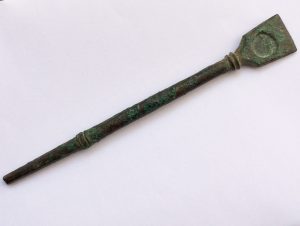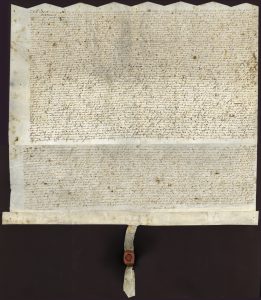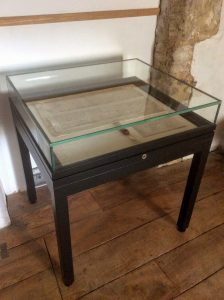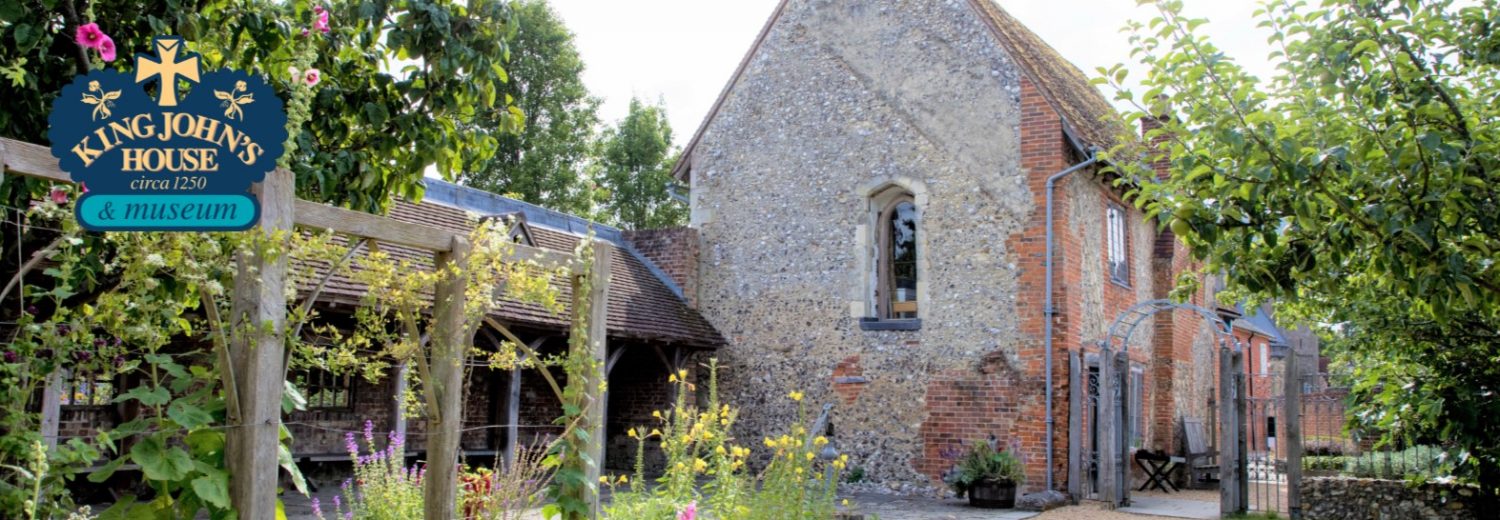One of the Trust’s prime responsibilities is the care and conservation of the artefacts in its care. To this end a dedicated group of volunteers looks after the varied collection of artefacts within King John’s House and the Moody Museum. The buildings that form the complex – the medieval King John’s House, Tudor Cottage and the Victorian home of the Moody family – are themselves the most notable part of the collection. But there are many other items of varying sizes and significance, either on open display or (for want of space) carefully stored for occasional exhibitions. The Trust aims to gather artefacts that tell the story of the buildings, the people who have lived in them and way those people have interacted with the history of Romsey and its locality
It is the role of the Collections team to ensure that all items are looked after to the standards required of an accredited museum. This involves storing in archival quality materials; maintaining high presentation standards; and the monitoring of bug traps, light levels, relative humidity, temperature and environmental conditions overall. It also involves future planning and innovations, as well as refreshing some ‘permanent’ aspects of the visitor experience.
A FEATURED ARTEFACT
Saxon Stylus
There was no museum facility in Romsey in the 20
th century, and artefacts found during archaeological excavations were deposited with Hampshire County Museum Service (now part of Hampshire Cultural Trust) at Chilcomb House, Winchester. The most significant finds are now on long-term loan to the Trust and are on show in King John’s House.

One item, in particular, has raised considerable interest in the past year. This is a small bronze artefact found with other small bronze items during an excavation in Narrow Lane c1982. At the time these were identified as Roman with the item of interest declared to be a Roman spatula. This was studied with close interest by a Romsey archaeologist whose speciality has been the Saxon period. She realised that the ‘spatula’ end was, in fact, the top of a Saxon stylus with an indentation which once probably held a semi-precious stone. The working point of the stylus (or pencil) has broken off but it would once have been used to press words into a clay tablet.
The presence of a stylus in Saxon times has exciting implications as it suggests a certain level of literacy in Romsey at that time.
King John's House has a fascinating collection of artifacts from around the Romsey area varying from a fossilised Mammoth tooth; to medieval graffiti; to items from the old Moody shop on Church Street; to war medals and memorabilia. If you would like a closer look at an of the collection, or have any questions, please drop by or
contact us.
A New Home for an Old Document
Early last year members of the Trust’s Collections Committee requested an independent audit to assess strengths and weaknesses in the overall care of the artefacts in its care. This was to be a comprehensive review of public displays and behind the scene

s compliance with all the standards expected of an accredited museum.
This audit duly took place in April 2019 and, thankfully, the Trust was deemed to be on the right track generally. But some areas of improvement were suggested. This most notable outcome has been a new presentation of our most valuable artefact, valuable that is in the historic not financial sense. This artefact is our 1571 Bargain & Sale document, by which King Joh’s House with two other properties nearby changed hands for the grand sum of £68 13s 4d.
It had long been displayed vertically in a deep wooden-framed display cabinet, and was buckling under the pull of gravity. As a matter of urgency, it was strongly recommended that it should be professionally conserved and a new table-top cabinet obtained for horizontal display. Research showed that a cabinet of museum standard would be very expensive but two bodies came to the rescue. First came an offer from our regular supporters The Arts Society Romsey (formerly NADFAS) who organise our rota of Collections volunteers and had already sponsored a 19
th-century Volunteers’ flag.

Then a successful appeal for a grant from Hampshire Archives Trust brought the whole project within our grasp.
The cabinet was ordered, the document handed over to Lancefield paper conservators, and the whole display came together in the new year. The deed is now safely within an environment that is appropriate for its beautifully conserved condition. It still, however, needs to be protected from harmful light levels, so is protected by an elegant calico cover with a colourfully embroidered invitation to visitors PLEASE LIFT ME.
A reception was planned for 1
st April as a thank you to all who had contributed towards this project but, sadly, events took over and this event was one of the casualties of the national ‘lockdown’. Featuring this project on our website is a small way of acknowledging all who have helped us.
Objects of Interest:

Cup from Drinking Fountain
Other interesting objects include:
Read more about each item here:
A Letter and Envelope sent to the Western Front, July 1916
A Programme of Events from the Romsey Pageant, 1907
Medieval Graffiti
Mazawattee Tea
Lord Mountbatten's Inkwell
Medieval Face Jug
Victorian Sunday School Rewards
Robert Smeetham Scout Medal of Merit
Post Medieval Bone Floor
Paleolithic Hand Axe with Fossilised Urchin Imprint
Eighteenth Century Wig Curlers
Curio From Romsey Abbey
 One item, in particular, has raised considerable interest in the past year. This is a small bronze artefact found with other small bronze items during an excavation in Narrow Lane c1982. At the time these were identified as Roman with the item of interest declared to be a Roman spatula. This was studied with close interest by a Romsey archaeologist whose speciality has been the Saxon period. She realised that the ‘spatula’ end was, in fact, the top of a Saxon stylus with an indentation which once probably held a semi-precious stone. The working point of the stylus (or pencil) has broken off but it would once have been used to press words into a clay tablet.
The presence of a stylus in Saxon times has exciting implications as it suggests a certain level of literacy in Romsey at that time.
King John's House has a fascinating collection of artifacts from around the Romsey area varying from a fossilised Mammoth tooth; to medieval graffiti; to items from the old Moody shop on Church Street; to war medals and memorabilia. If you would like a closer look at an of the collection, or have any questions, please drop by or contact us.
One item, in particular, has raised considerable interest in the past year. This is a small bronze artefact found with other small bronze items during an excavation in Narrow Lane c1982. At the time these were identified as Roman with the item of interest declared to be a Roman spatula. This was studied with close interest by a Romsey archaeologist whose speciality has been the Saxon period. She realised that the ‘spatula’ end was, in fact, the top of a Saxon stylus with an indentation which once probably held a semi-precious stone. The working point of the stylus (or pencil) has broken off but it would once have been used to press words into a clay tablet.
The presence of a stylus in Saxon times has exciting implications as it suggests a certain level of literacy in Romsey at that time.
King John's House has a fascinating collection of artifacts from around the Romsey area varying from a fossilised Mammoth tooth; to medieval graffiti; to items from the old Moody shop on Church Street; to war medals and memorabilia. If you would like a closer look at an of the collection, or have any questions, please drop by or contact us.
 s compliance with all the standards expected of an accredited museum.
This audit duly took place in April 2019 and, thankfully, the Trust was deemed to be on the right track generally. But some areas of improvement were suggested. This most notable outcome has been a new presentation of our most valuable artefact, valuable that is in the historic not financial sense. This artefact is our 1571 Bargain & Sale document, by which King Joh’s House with two other properties nearby changed hands for the grand sum of £68 13s 4d.
It had long been displayed vertically in a deep wooden-framed display cabinet, and was buckling under the pull of gravity. As a matter of urgency, it was strongly recommended that it should be professionally conserved and a new table-top cabinet obtained for horizontal display. Research showed that a cabinet of museum standard would be very expensive but two bodies came to the rescue. First came an offer from our regular supporters The Arts Society Romsey (formerly NADFAS) who organise our rota of Collections volunteers and had already sponsored a 19th-century Volunteers’ flag.
s compliance with all the standards expected of an accredited museum.
This audit duly took place in April 2019 and, thankfully, the Trust was deemed to be on the right track generally. But some areas of improvement were suggested. This most notable outcome has been a new presentation of our most valuable artefact, valuable that is in the historic not financial sense. This artefact is our 1571 Bargain & Sale document, by which King Joh’s House with two other properties nearby changed hands for the grand sum of £68 13s 4d.
It had long been displayed vertically in a deep wooden-framed display cabinet, and was buckling under the pull of gravity. As a matter of urgency, it was strongly recommended that it should be professionally conserved and a new table-top cabinet obtained for horizontal display. Research showed that a cabinet of museum standard would be very expensive but two bodies came to the rescue. First came an offer from our regular supporters The Arts Society Romsey (formerly NADFAS) who organise our rota of Collections volunteers and had already sponsored a 19th-century Volunteers’ flag.
 Then a successful appeal for a grant from Hampshire Archives Trust brought the whole project within our grasp.
The cabinet was ordered, the document handed over to Lancefield paper conservators, and the whole display came together in the new year. The deed is now safely within an environment that is appropriate for its beautifully conserved condition. It still, however, needs to be protected from harmful light levels, so is protected by an elegant calico cover with a colourfully embroidered invitation to visitors PLEASE LIFT ME.
A reception was planned for 1st April as a thank you to all who had contributed towards this project but, sadly, events took over and this event was one of the casualties of the national ‘lockdown’. Featuring this project on our website is a small way of acknowledging all who have helped us.
Then a successful appeal for a grant from Hampshire Archives Trust brought the whole project within our grasp.
The cabinet was ordered, the document handed over to Lancefield paper conservators, and the whole display came together in the new year. The deed is now safely within an environment that is appropriate for its beautifully conserved condition. It still, however, needs to be protected from harmful light levels, so is protected by an elegant calico cover with a colourfully embroidered invitation to visitors PLEASE LIFT ME.
A reception was planned for 1st April as a thank you to all who had contributed towards this project but, sadly, events took over and this event was one of the casualties of the national ‘lockdown’. Featuring this project on our website is a small way of acknowledging all who have helped us.













Follow Us